Forex Trading is regulated in New Zealand by the Financial Markets Authority (FMA). FMA is the statutory regulatory body that oversees financial markets including the forex market in New Zealand. They also issue licenses to market participants like the forex brokers that accept retail traders.
For ensuring that your funds are safe, New Zealand-based traders must only trade via FMA-regulated CFD & forex brokers.
Also, it is important to understand that forex & CFD trading is very risky, and almost 70-80% of retail traders lose their money when trading at different CFD brokers in New Zealand. Hence, if you are thinking about trading forex, then you must learn about the risks as well.
5 Steps to Start Forex Trading for Beginner Traders in New Zealand
Below are some of the points that you need to know in learning everything about forex trading:
- Learn about the Basics of Forex Market
- Understand how Currency Pairs work
- Learn the Forex Trading Terminology
- Open your Forex Trading Demo Account
- Lean about all the Risks Involved in Forex Trading
- Learn how to Analyze the Forex Market
In this guide, we will mostly discuss the point of view of retail traders in the forex market. We will try to cover some of the topics that can help you decide if you should trade, and learn about the risks involved. Or simply learn about forex trading.
Show More
Summary & Comparison of Best Forex Brokers in New Zealand
Note: The spread data on minimum deposit is the typical/minimum spread as per information on these brokers’ websites in January 2024.
What is the Forex Market?
The foreign exchange market alias forex or FX market is a global, online over-the-counter (OTC) market where currencies of about 170 countries are bought and sold. It is open 24 hours a day. It is the biggest financial market in the world and has very high liquidity.
According to the Bank of International Settlement (BIS) survey conducted every three years, as of 2019, the NZD ranked tenth (globally) in OTC foreign exchange, accounting for 2% of the total turnover. The forex market participants include businesses, banks, speculators, institutions, etc.
Most of the trading is from banks, businesses & institutional investors. Some of the tradings in the forex market are speculative, and a part of them is from retail traders. Retail traders come to the forex market to speculate, hedge against currency and interest rate risk, etc.
The activities that take place in the forex market determine the exchange rate of any currency pair. The higher the demand for a currency, the higher its exchange rate.
Forex Market Participants
The forex market ecosystem teems with a lot of participants. Let us discuss some of them.
1) The forex broker
The forex broker is a regulated participant who acts as a bridge between the forex trader and the market.
The broker is a middleman who places buy and sell orders for retail traders and some brokers also offer research services as well if required by the trader. The forex broker charges a fee for their services.
That being said, retail traders need to pass through a forex broker that accepts retail traders if they are to access the market. There are several forex brokers in New Zealand to choose from.
However, traders in New Zealand should check the FMA website for a list of regulated forex brokers to avoid patronizing fraudulent/scam brokerages.
There are two types of brokers. They are classified based on their execution model. Here is the breakdown
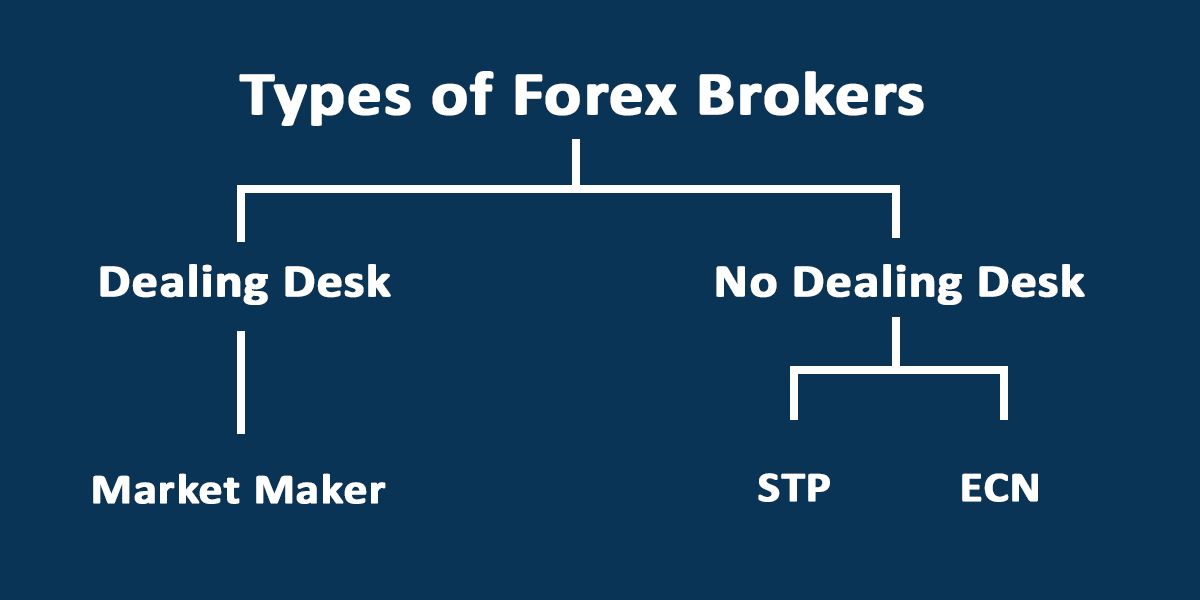
Dealing Desk Broker: Dealing desk brokers take the opposite side of your trades. When you buy a currency pair, they sell. When you sell, they buy. Because of this, when you lose a trade, they make money off it, leading to a conflict of interest. This is why traders tend to prefer non-dealing desk brokers.
Dealing Desk brokers are also known as market makers.
Non-dealing Desk (NDD) Broker: NDD brokers do not take the opposite sides of your trades and they are divided into two. There are NDD brokers that use computerized networks to connect you to buyers/sellers in the market. This type is referred to as a broker.
The second type is the STP brokers. They connect your trades to buyers/sellers via their liquidity pool.
2) The Retail Forex Trader
Retail forex traders are individual investors who wish to trade in the forex market for personal gain. They don’t trade on behalf of an organization or company. They account for an estimated 5.5% of the global forex market as per BIS data.
Retail traders are in the market mostly for speculative reasons. They hope to profit from differences in exchange rates between currencies.
3) Central Banks
Their presence in the forex market is to create policies that can affect the currency, intervene and stabilize the currency through increasing or decreasing interest rates, performing open market operations in some situations, etc.
Central banks can also devalue their currency to make exports of their country more competitive to international buyers. In short, the Central bank plays a major role in deciding the value of a currency.
4) Commercial Banks
Commercial Banks make up the interbank market where they trade forex with other banks in very large volumes. These volumes are large enough to dictate the bid and ask prices for any currency. They trade on behalf of themselves and their customers.
5) Multinationals
Big companies that operate in different parts of the world have to trade in the forex market to hedge risk and also for business purposes.
A company hoping to buy raw materials from another part of the world may need to convert its currency to be able to pay the supplier at the other end.
Big companies that have business operations in other parts of the world may also want to convert and repatriate their profits in a stronger currency to hedge against the risk of currency depreciation.
Forex Market Time Zones
The forex market operates in four different time zones-
- Auckland (12am GMT to 9am GMT)
- Tokyo (11pm GMT to 8am GMT)
- London (7am GMT to 4pm GMT)
- New York (12pm GMT to 9pm GMT)
Depending on the currency that you want to trade, some sessions can be better than others. Most of the trading is carried out in the London & New York sessions.
The best time to trade the majors is when some of the major sessions overlap. At this time, market participation and liquidity are high, and spreads are at their lowest.
For example, the ideal time to trade the GBP/USD currency pair is when the London & New York sessions overlap. Because at that time liquidity in the market is highest.
If you are trading JPY-based pairs, then you will also find liquidity during the Asian session.
What are Currency Pairs?
All the countries participate in the forex market and their currencies are represented as three-letter codes.
However, we will focus on the popular currencies here. The popular currencies and their codes are listed below:
- U.S Dollar – USD
- Great Britain Pound- GBP
- Euro – EUR
- Japanese Yen – JPY
- Canadian Dollar – CAD
- Australian Dollar – AUD
Forex Currency Pairs
Forex currencies are traded in pairs written as Base Currency/Quote Currency – GBP/USD
Currency pairs could be major, minor, or exotic. Let us discuss them below.
1. Major Currency Pairs
The major currency pairs quote the USD alongside another major currency and are widely traded.
They usually have the USD on one side of the quote either as the base or quote currency. Examples in order of popularity are:
- EUR/USD
- USD/JPY
- GBP/USD
- USD/CHF
- AUD/USD
- USD/CAD
- NZD/USD
2. Minor Currency Pairs
These are currency pairs of strong economies that do not contain the USD. Examples are
- EUR/GBP
- GBP/JPY
- GBP/CHF
- EUR/CHF
- EUR/JPY
- CHF/JPY
- AUD/JPY
3. Exotic Currency Pairs
These are currency pairs involving a major currency and a currency of a smaller economy. These smaller economies are often referred to as emerging economies. Examples are:
- USD/SEK- USD/Swedish Krona
- USD/DKK- USD/Danish krone
- USD/ZAR- USD/South African Rand
- USD/KES- USD/Kenyan Shilling
- USD/NGN- USD/Nigerian Naira
Reading a Forex Quote
Forex currencies are traded in pairs written as Base Currency/Quote Currency i.e. GBP/USD. The base currency is usually on the left while the quote currency will be on the right. Here is an illustration below:
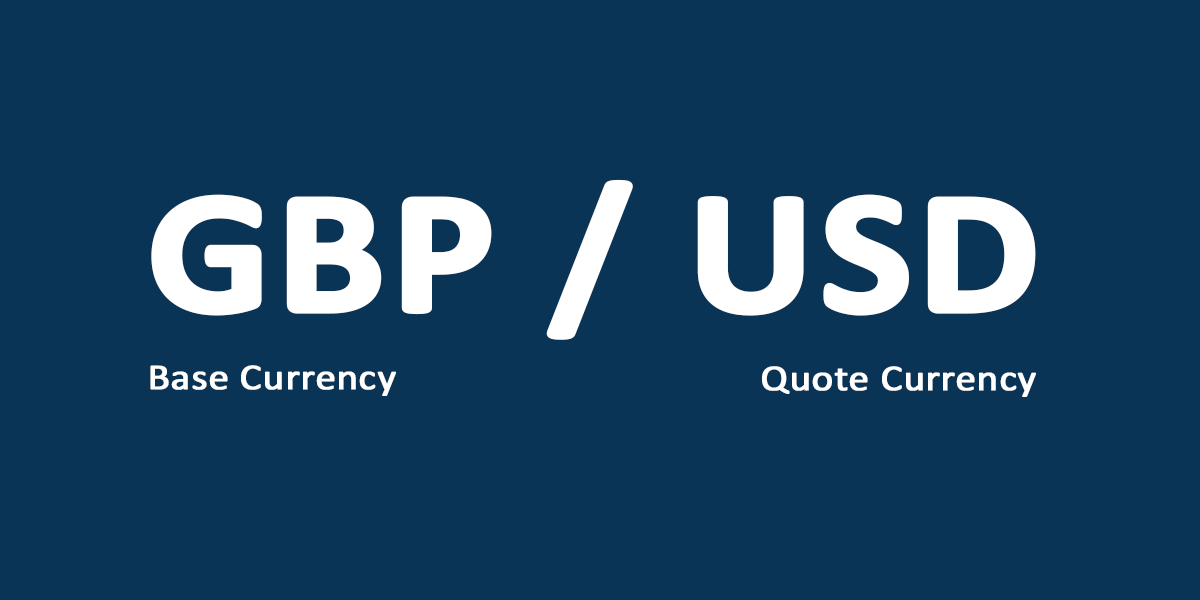
When you go long (buy) on a currency pair, the base currency is being bought while the quote currency is being used to pay for the base currency. It is the other way round when you go short (sell) on a currency pair.
Currencies are always traded in pairs at an exchange rate. The exchange rate is how much of the quoted currency is required to buy the base currency.
Assume the GBP/USD exchange rate = 1.2
This means that it will take US$1.2 to buy one GBP and vice versa.
While trading forex, we use one currency to buy another hence we can also quote the currencies in terms of BID/ASK prices
The Bid price is the highest price a forex trader is willing to pay to buy the base currency from the broker.
The Ask price is the lowest price the forex broker is willing to sell the currency.
Below is an illustration to help you understand
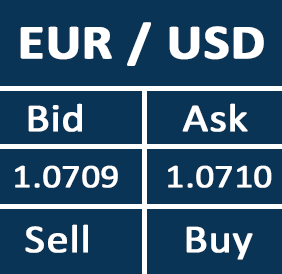
Forex brokers quote these two prices on their trading platforms. They are always obvious that you cannot miss them.
Forex Trading Terminologies
Certain terms are widely used in forex trading and understanding is very important. We shall discuss some common terms below.
1) Spread
Spread is the difference between the bid (buy) price and the ask (sell) price of a currency pair. It is basically a markup added to the ask price by the forex broker.
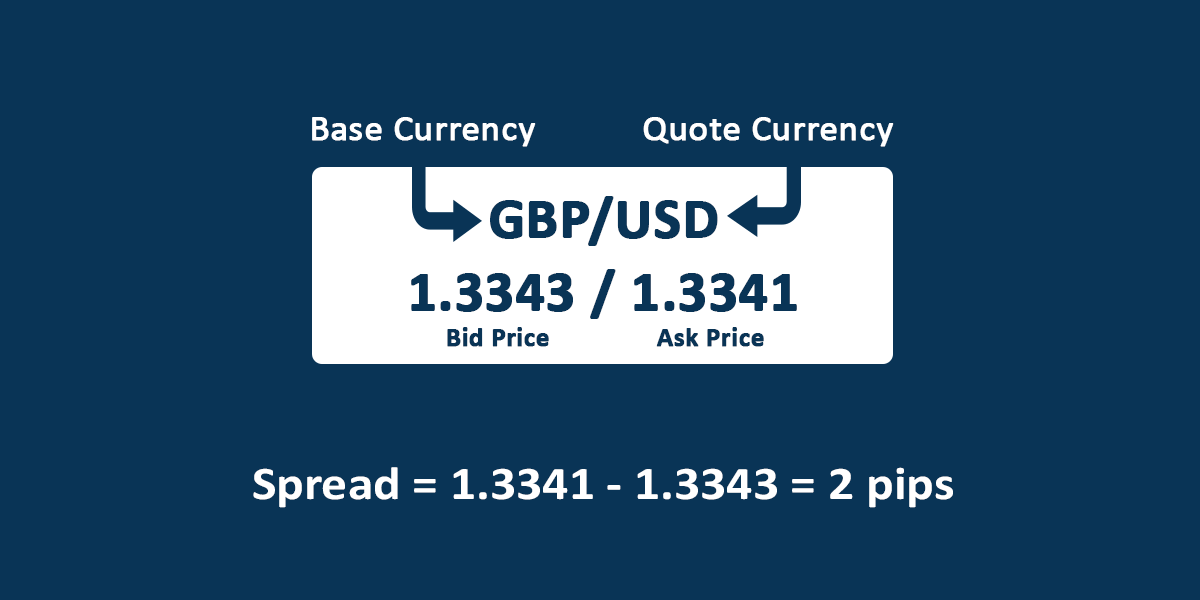
As seen in the image above the GBP/USD currency pair with a Bid/Ask price of 1.3089/1.3091 has a spread of 1.3089-1.3091 = 0.0002
Your forex broker may not always charge you a commission but makes their profit from the spread. A spread of 0.0002 means if you are trading in a standard lot of 100,000 units of GBP/USD currency, the forex broker makes $20 on every standard lot traded i.e. 0.0002 x 100,000
There are two types of spreads in forex:
Variable spreads: As the name implies, variable spreads are spreads that fluctuate. This fluctuation is due to changes in the condition of the market like high or low volatility. This type of spread is usually offered by NDD brokers as they try to get the best market price for your trades.
Fixed Spreads: These are spreads that remain the same regardless of market conditions. They are usually offered by market makers. Market makers determine the price of the currency pairs they offer. So they can keep the bid and ask price fixed no matter the market condition.
2) Pips
Percentage in point alias “pips” is the unit of measurement for the spread.
As seen in the example above, if the spread is 0.0002 it is conventionally expressed as 2 pips. This is for a currency up to the fourth decimal. JPY pairs are usually to the second decimal (e.g. 0.01)
3) Lots
Forex pairs are traded in units called lots.
Since the currencies don’t move by a lot, the traders tend to trade a higher number of units. Remember, the higher the traded volume, the larger the potential profit & loss.
Currency pairs are divided into various lots as seen in the table below.
| Lot |
Number of units of currency |
| Standard |
100,000 |
| Mini |
10,000 |
| Micro |
1,000 |
Standard lot example:
For a GBP/USD currency pair with details below-
Exchange rate = $1.36
Standard lot = 100,000 units
The margin needed for trading 1 standard lot will be $136,000 (i.e., $1.36 x 100,000)
Mini lot example:
For a GBP/USD currency pair with details below-
Exchange rate = $1.36
Mini lot = 10,000 units
The balance required for trading a Mini lot will be $13,600 (i.e. $1.36 x 10,000)
So, the margin that you need to trade depends on the total lots or units that you are trading. If you are trading 2.5 Mini Lots, this means that you are trading 25,000 units of a currency.
4) Leverage
Leverage in forex trading is essentially taking a loan from your forex broker to trade more lots. The loan is repaid after you sell and make a profit or a loss.
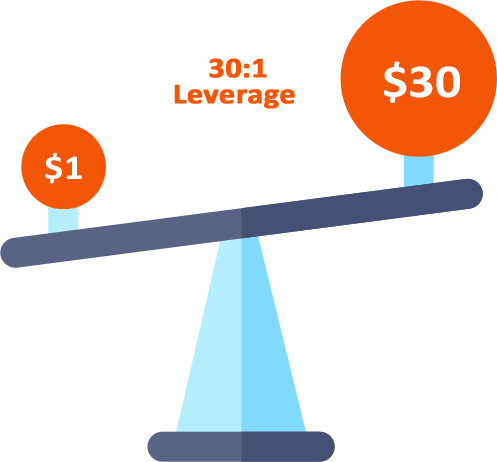
Most retail forex traders don’t have the required capital to buy or sell thousands of units of currency pair, so they leverage their position. But this is very risky and can result in huge losses.
Leverage of 30:1 means for every $1 a forex trader can trade up to a $30 position using margin money.
Leverage is inversely proportional to margin. In New Zealand, there used to be no leverage restriction. Forex brokers could offer up to 3000:1 leverage which is detrimental to traders.
Example:
If margin is 3.33%, then leverage is 1/3.33 = 30 (also expressed as 1:30)
Since leveraging means taking a loan, it is a double-edged sword.
For example, if you lose big on a trade, and if the forex broker does not have Negative balance protection in place, the trader may have to repay more than the initial capital if the losses exceed capital.
This is why the leverage that brokers can offer to retail traders for CFDs & forex is set limits between 30:1 and 2:1 (depending on the instrument) by some regulators.
In New Zealand, there used to be no leverage restriction. Forex brokers could offer up to 3000:1 leverage which is detrimental to traders. Since the FMA took over the regulation of forex trading in New Zealand, a maximum leverage of 500:1 has been set for trading currency pairs.
5) Margin
This is a good faith deposit a trader must keep in his trading account to enable him to open a trade with leverage. It is expressed as a percentage and is inversely proportional to leverage.
Margin % = 1/Leverage
For leverage of 30:1, the margin is 1/30 = 3.33%
Example:
If a forex trader uses leverage to place a buy order of 1 standard lot of GBP/USD currency pair
GBP/USD Exchange rate = $1.33
Margin = 3%
Required deposit without margin = $133,000 (i.e. 100,000 units x $1.33)
Required deposit with 3.33% margin= $4428.9 (i.e. 3.33% of $133,000)
After the forex trader deposits $4,428.9 in his or her account, then the 1 standard lot trade on GBP/USD can be placed.
6) Negative Balance protection
This is a system put in place by forex brokers to ensure your account does not go into negative when the market moves against you quickly.
If a trade position you open is unsuccessful and you suffer a loss that exceeds your deposit, any negative balance that accrues will be reset to zero.
Once you lose the deposits in your CFD trading account, the brokerage system automatically closes all your positions.
It limits your loss to just your capital and ensures that the forex broker does not take the risk of your position. Negative balance protection is offered to only retail traders and not institutional traders.
Most regulated brokers in New Zealand offer negative balance protection which ensures that you do not lose more than the money you deposited.
7) CFDs
CFDs are derivatives, and these are contracts between the broker & trader. Derivatives are complex financial instruments that derive their value from other underlying assets such as Stock, Currency, Commodities like Gold, precious metals, etc.
When trading CFDs, a trader does not own the underlying asset and is only speculating on the price of the instrument. There are a number of CFD trading platforms you can choose from in New Zealand.
8) Hedging
This is the act of managing risk.
Traders sometimes trade derivative instruments such as currency futures and currency options to hedge against currency and interest rate fluctuation risk.
9) Day Trader
This is a trader who opens and closes trading positions on the same day. Day traders are usually speculators and use derivative products like CFDs to try to profit from the rise or fall of the price of an asset.
10) Forex Orders
A forex order is simply how you enter and exit the market. They are the offers you send to your broker from trading platforms. There are different types of orders you can place in the market. Here are the common ones:
Buy Order: This involves placing an order to purchase a currency pair. This order is instant. However, it has two variations called the buy stop and buy limit orders. A buy stop is when you set your entry price above the current market price. If the price rises to the level you have set, your buy order is triggered.
On the other hand, a buy limit means setting your entry price below the current market price in hope that the price will fall to that level. If it does, your buy order will be triggered.
Sell Order: It involves placing a trade to short (sell) a currency pair. A sell order is instant but has two variations too – the sell stop and sell limit orders. For a sell stop, you place your order at a price below the market price with the hope that the price will fall further from that point. If the price falls to the point you have set, your sell order will be activated.
For the sell limit, you place your sell order at an entry price above the current price, with the hope that the price will fall from there. If the price rises to the point you have set, your sell order will be activated.
Take Profit: It literally means what the name suggests. It is that price you set for your broker to close your trades and lock in your profits. The order is usually executed automatically on the trading platform. You can also execute it manually.
Stop Loss: If a trade goes against you, you are losing money. There is a limit to losses that you can take as a trader. This is why the stop loss order is important. It is that price you set for your broker to close your trade to reduce losses. It can be executed automatically or manually.
There is an advanced form of the stop loss order called the guaranteed to stop loss order (GSLO). This order makes sure that your stop loss order is executed at the exact price you choose so you don’t lose more money. That is, your stop loss order is not subjected to slippage. A premium fee is usually charged for GSLO. Though it is not offered by all brokers, GSLO can be very key to your risk management strategy.
Trailing Stop: The trailing stop is similar to the stop loss because it automatically closes your trade if price movement is unfavorable. Also, it does this within a specified distance. But they differ in one crucial way.
When price moves in your favor, it moves the trailing stop along with it. Trailing stop allows you to capitalize on favorable market movement while managing your risk effectively.
11) Copy Trading: Not all traders have the time to sit with charts, analyze, and place trades. For such traders, copy trading is very essential. It is a way of trading that allows you to replicate the trades of successful traders in your account. This can be automated or executed manually.
12) Expert Advisors: Also known as EAs, expert advisors are programmed trading bots that run on trading platforms. They analyze the market according to the conditions and parameters you set in them. Based on this analysis, they can suggest a trade for you or place a trade automatically.
How to Start Forex Trading
Here is a step-by-step guide that will help you start your forex trading experience.
1) Education: It is essential you learn the basics of forex trading. You need to know about currency pairs, exchange rate, and some the definition of a number of terms. You also need to know how the forex market operates plus fundamental and technical analysis.
2) Understand Risk: Forex trading is risky. More than 70% of retail forex traders lose their money when trading. You must understand that you will be trading with leverage which can lead to total loss of your trading capital.
3) Choose a Broker: You should research and choose a reliable broker. You should compare different brokers based on factors such as regulation, trading fees, customer support, etc. Ensure the ASIC regulates any broker you choose.
4) Trading Plan: You need to create a concise trading plan. It should contain your trading strategy, goals, and risk appetite. This is essential for you to remain disciplined in trading.
5) Trading Strategy: Choose the trading strategy you want to employ. Do you want to scalp? Do you prefer day trading? You might even prefer swing trading. Your trading strategy should also include your entry and exit conditions. This will help you avoid random trading.
6) Open a Demo Account: A demo account is a practice account. It allows you to test your trading strategy without risk of losing money. Your broker will give you virtual money that you can trade in a simulated environment. You will be familiarized with the market and your trading platform.
7) Open a Real Account: After you have practiced on a demo account, you can proceed to opening a live account. At this point, you are in the market and can trade with real money. Try not to go all in. Start with small money and try growing from there.
How to Open Forex Trading Account?
To open a forex trading account, you need to first choose a reputed broker that is regulated by FMA. Many brokers are regulated, so you should compare forex brokers by checking their regulation and safety of funds, trading and non-trading fees, trading application platforms supported, instruments, customer support, ease of deposits/withdrawals, etc.
After you have done your research and decided on the forex broker that you want to choose, then you should proceed with opening your trading account. We will take Plus500 as an example. The steps involved are generally the same for all forex brokers.
To start trading forex in New Zealand, follow the steps below to create a live trading account.
Step 1: Go to the Plus500 website homepage via www.plus500.com and Click the button labelled ‘Start Trading’ on the top right side of this page, or ‘Start Trading Now’ at the page centre.
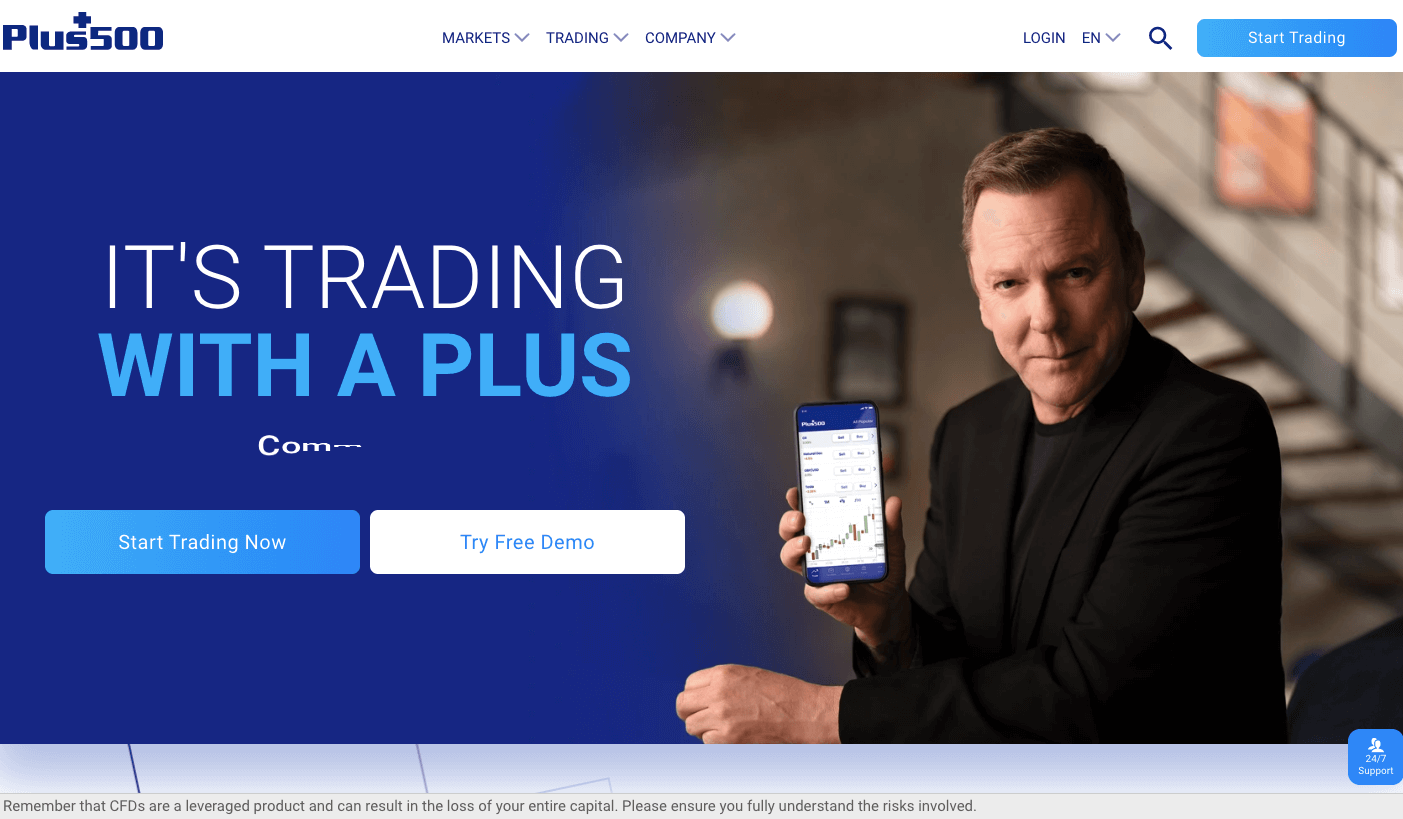
Step 2: Input your email and create a password on the form that appears then click ‘Create Account’. You will be redirected to the Plus500 WebTrader.
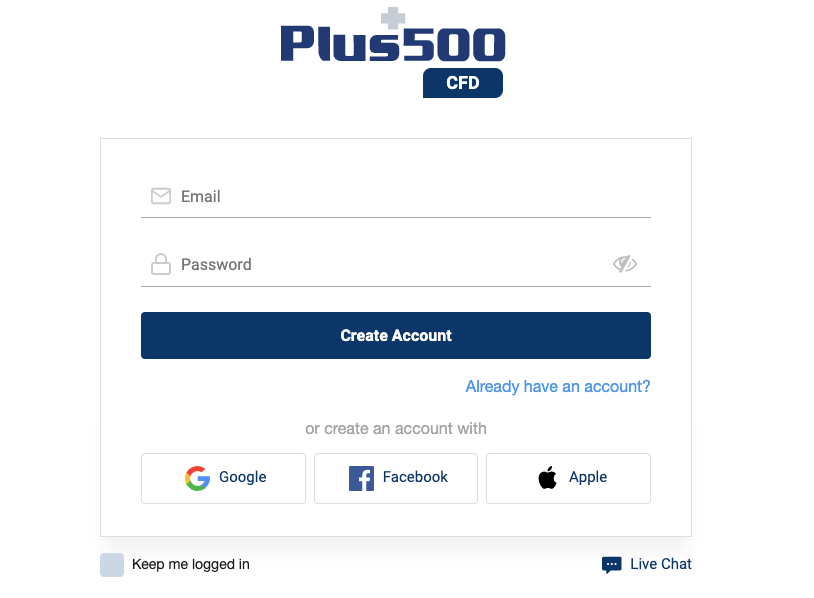
Step 3: To complete your registration, click on the three bars on the left side of the WebTrader, then follow the ‘Get Started’ link.
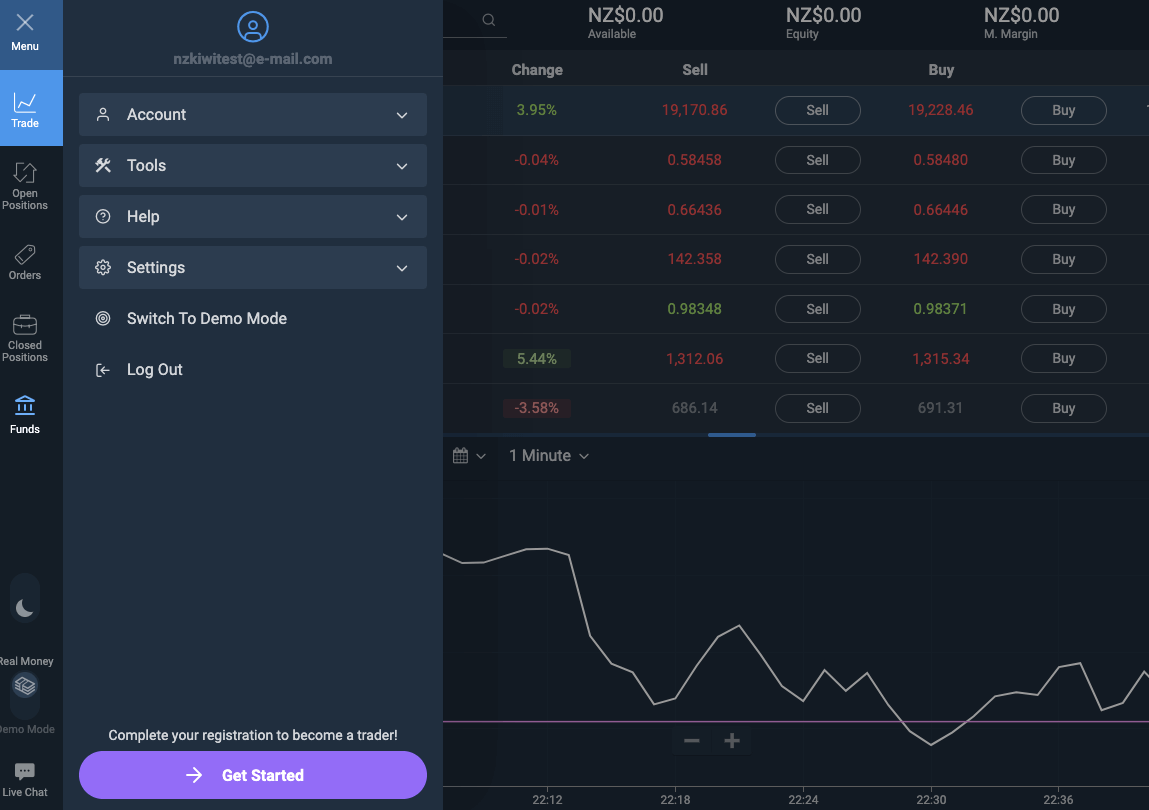
Step 4: Provide your full name and date of birth and fill out the address information, and driver’s license number then click ‘Next’.
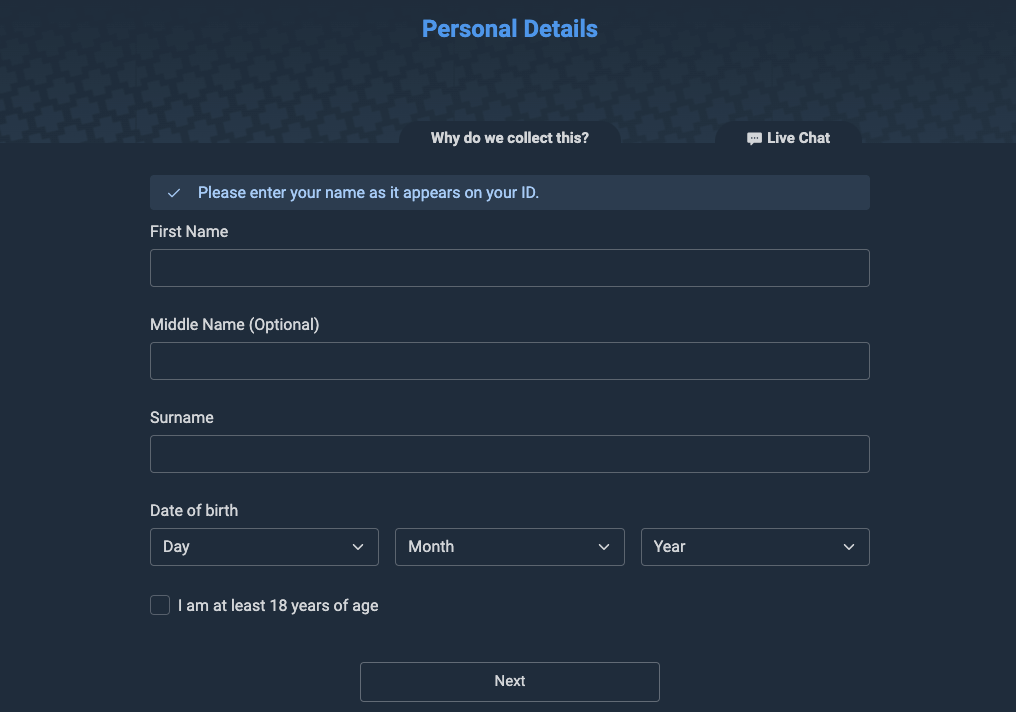
Step 5: Answer questions about your experience trading CFDs, employment, financial status and knowledge of leveraged trading.
After that, check the box to agree to the terms and conditions and click ‘Finish’.
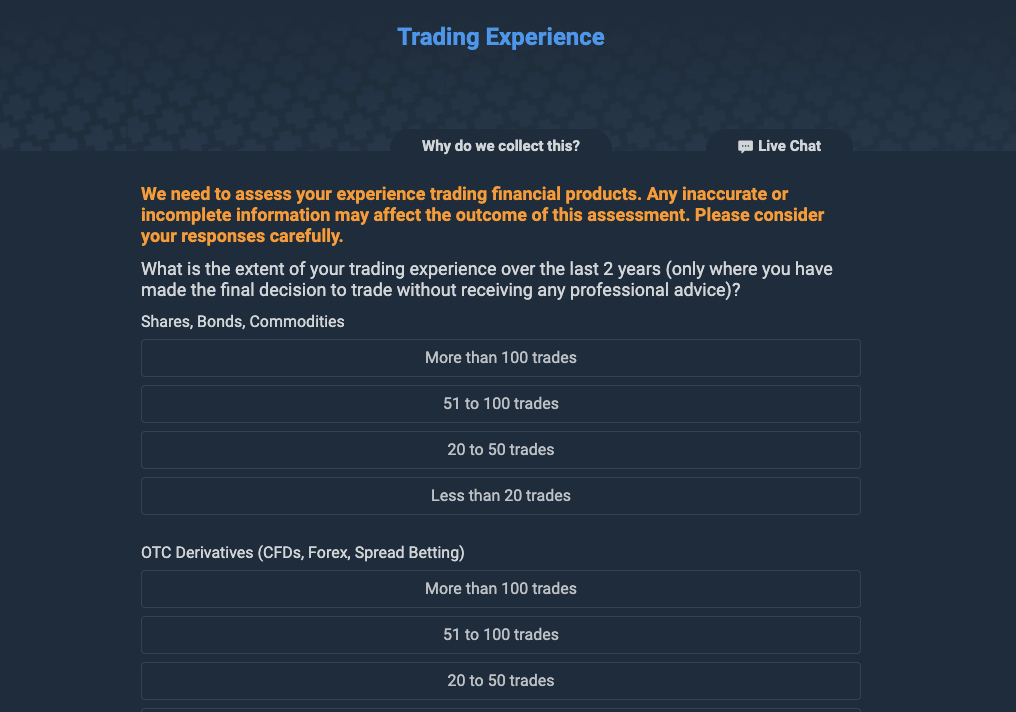
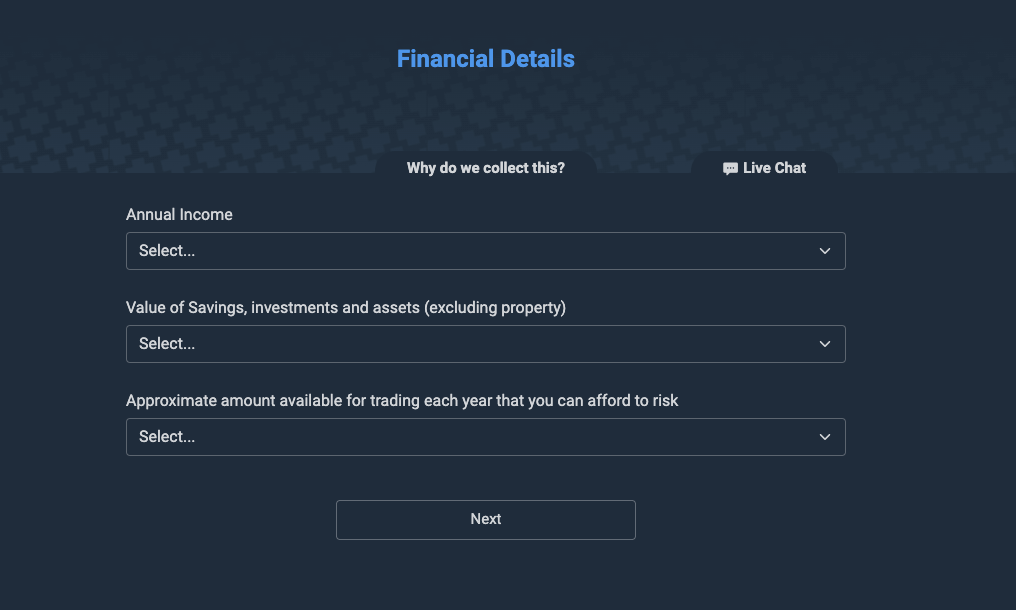
Step 6: You will be taken to the Plus500 dashboard which is the WebTrader.
Now, you will need to verify your account to access the full account features.
To verify your account, click on the menu (three bars) on the left, then select ‘Account’ and click on ‘Verify Account’.
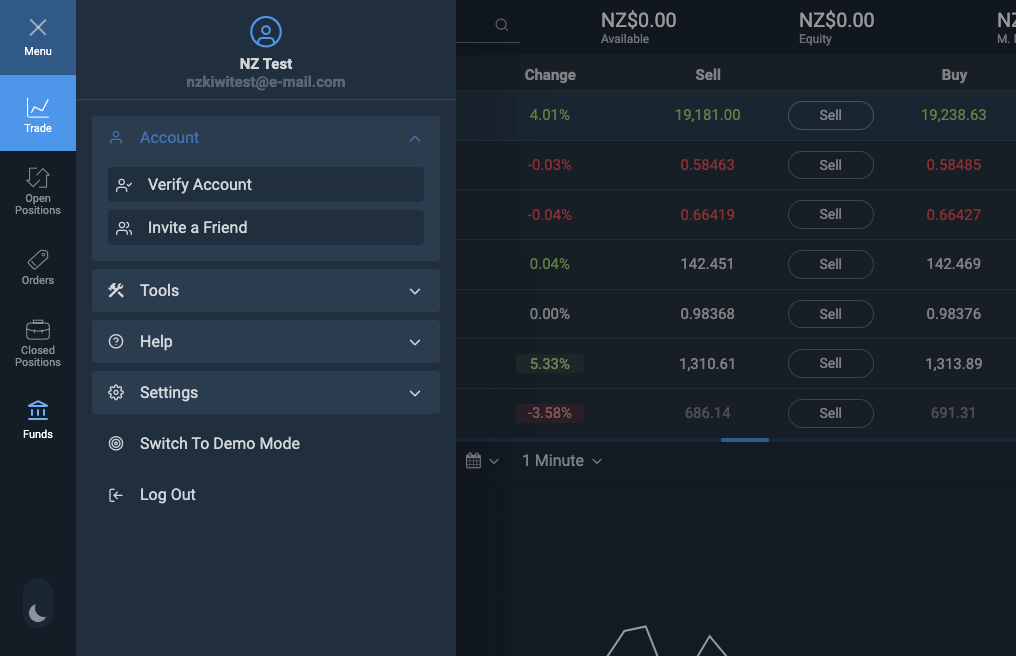
Step 7: You will be required to upload some documents to verify your identity and address.
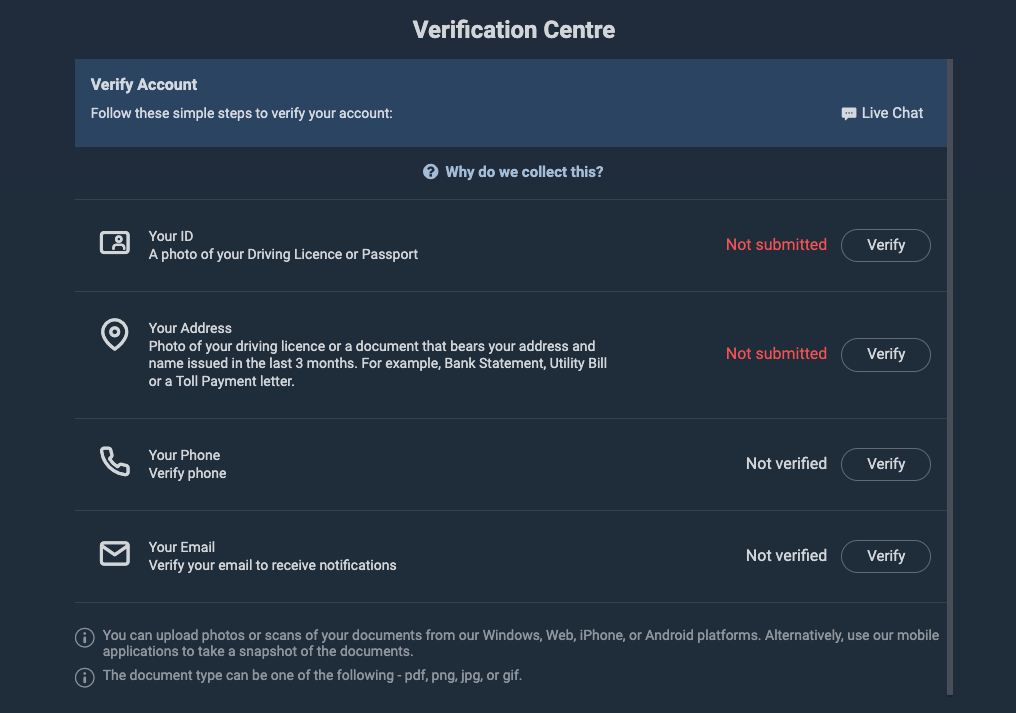
After your account is verified, you can make deposits, trade, and withdraw funds.
It is advisable that you only choose a forex & CFD broker that is regulated by FMA. Trading with unregulated brokers would mean that you could lose all your deposited funds.
Also, avoid any brokers that charge excessive withdrawal fees. Some brokers claim to charge low trading fees, while charging excessive charges on withdrawals & deposits, making their overall fees very high.
What are Forex Trading Platforms?
Forex brokers act as intermediaries between traders and the market. When you open a trading account, you will need a platform to analyze CFDs, and place and monitor your trades. These platforms are offered by CFD brokers and they are divided into two categories. They are ‘third-party’ and ‘proprietary’ platforms. A forex broker can have both or one of the categories.
Third-party platforms are trading apps or software developed by another company. Forex brokers partner with these companies to develop these platforms for them. A common example of these is MetaTrader 4, MetaTrader 5, and cTrader. These three are the most popular trading platforms. They are available on mobile phones, desktops, and web-based trading platforms. You can download them from your broker’s website. The mobile versions are available on Google Play Store and App Store.
In addition, there are third-party platforms that allow forex brokers to link their client’s accounts to their own platforms. TradingView is a typical and common example of this kind of platform.
Proprietary platforms are the opposite of third party platforms.They are owned and developed by individual forex brokers. Some forex brokers prefer to develop their own apps and software for traders. They can be available on mobile, desktop, or on the web. eToro, for example, does not have any third-party platforms. They only offer their CFD trading platform and Copytrader.
Risks Involved in Forex Trading
The forex market is very liquid and this liquidity has caused a lot of traders to throw caution to the wind and even become greedy.
Most retail traders trade forex because of leverage, and this can cause losses to escalate very quickly.
Let us discuss some risks.
1) Risk of Unlicensed Forex Brokers
There are lots of unlicensed brokers who lure unsuspecting traders with promises of huge returns with low investments.
Some of them claim to hold licenses from regulators in countries that are not known for strong regulatory supervision.
Forex traders in New Zealand must only trade via FMA-licensed forex brokers. Traders should go to the FMA website via www.fma.govt.nz/business/licensed-providers/ and check if their broker is on the list of licensed forex brokers.
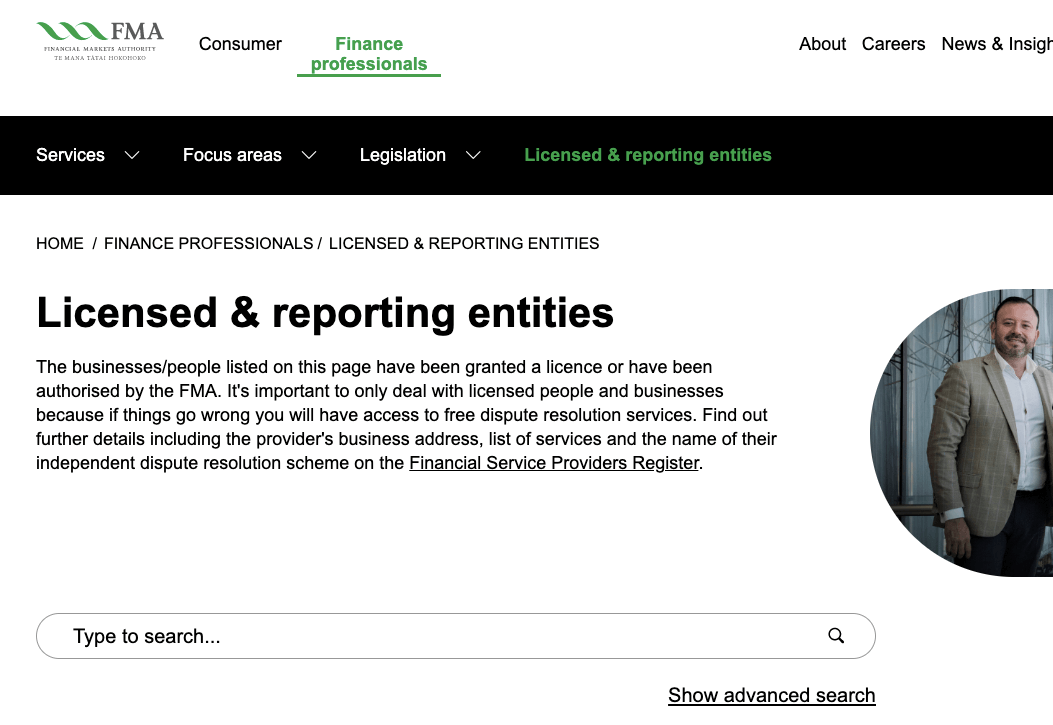
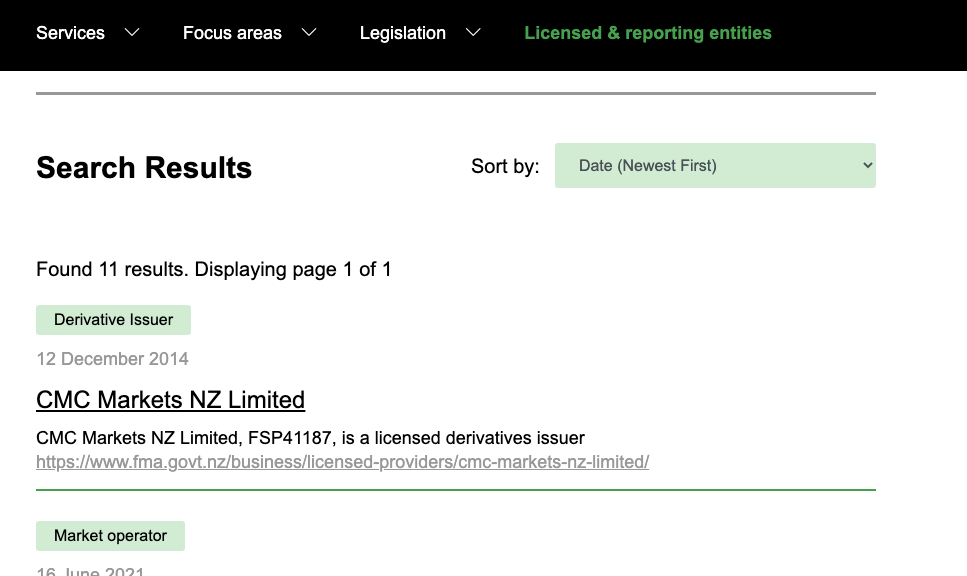
The FMA licensed financial providers list also shows the Financial Service Provider (FSP) number, when the forex broker was first licensed in New Zealand, and whether the license is still active. This information and the one on the broker’s website should match.
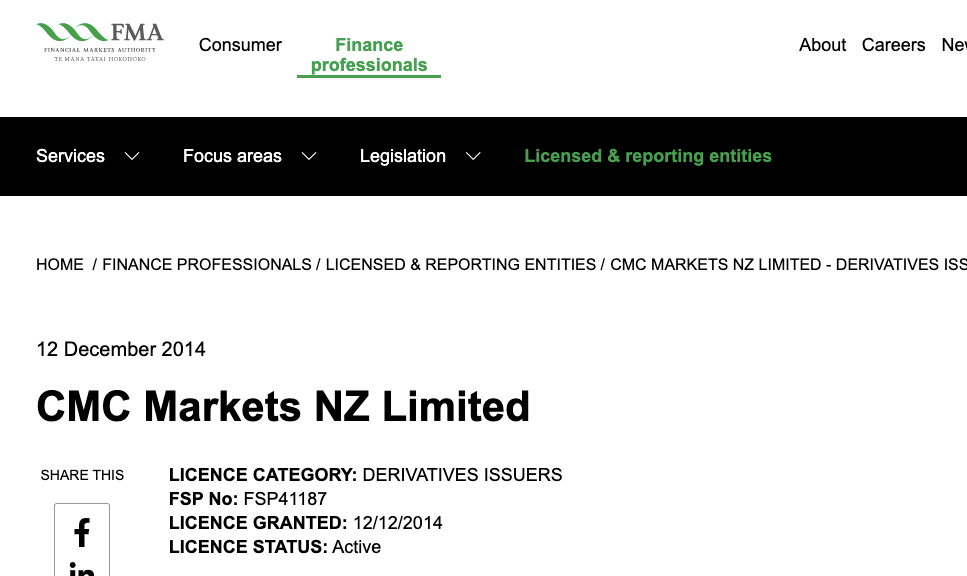
2) Leverage Risk
FMA has not set any clear leverage restrictions that brokers in New Zealand can offer to traders. This means forex brokers can offer any amount of leverage, although they usually offer between 2:1 to 500:1.
This being said, forex traders should resist the urge to open an account with brokers outside New Zealand who offer higher leverage. This restriction is set so that retail traders do not lose excessively.
Reports state that even with leverage restrictions, 70 to 80% of retail forex traders lose money. The actual percentage varies from broker to broker.
This is mainly because of over-leveraging a position. Traders must avoid using more than 1:10 leverage on any forex trade.
Let’s take an example, let’s say you place a buy order on EUR/USD at 1.1000 targeting 1.1100, which is 100 pips. You have $10,000 in your trading account & you decide to use 1:10 leverage to place 1 Standard lot trade.
If the price does go in your direction, then you can make a profit of $1000 on this trade. But if the price goes against you by let’s say 100 pips, then you would lose $1000, which is 10% of your capital. If you had used 1:30 leverage, then the losses would have been $3000, which is 30% of your capital on a single trade.
Hence, you must remember that trading with excessive leverage can cause big losses.
The use of leverage should be done responsibly as it amplifies both gains and losses. You should find out if your broker offers negative balance protection to stop your account from going into negative.
You can also use stop-loss orders to automatically exit a position if the loss exceeds a certain level. Stop-loss orders are automated instructions a trader gives the broker to exit his trading position once the price goes below a predetermined amount. Stop-loss orders could be used to manage risk.
4) Risk of Losses From your Trades
The forex market is very volatile and should be approached with caution. For example, it is not uncommon for some currency pairs to move 4-5% in a day.
Normally, even majors like EUR/USD can move 1-2% in a single day. If you are risking too much on a single trade, then you can lose very quickly.
Most of the retail traders trading in the forex market lose their money. It is really hard to be profitable with forex trading, mostly because traders trade with gamblers’ nature of risking excessively.
It is really important to practice risk management on a demo account for some months before going live. Also do not risk more than 2% of your trading capital on one trade.
Types of Analysis in Forex Trading
In the world of forex trading, there are two major types of analysis — fundamental and technical analysis. Technical analysis focuses on price patterns (present and historical), indicators, use of drawing tools, etc. On the other hand, fundamental analysis has to so with how political and economic factors affect the value of currencies.
In this section, we will be breaking down both methods to help you understand them better.
1. Fundamental Analysis: The health of an economy is crucial to the strength of its currency. The aim of fundamental analysis is to determine how the health of an economy affects the value of its currency. There are different components of fundamental analysis that can help you determine the direction of price for a currency pair.
Here are some of them.
Economic indicators and releases: Economic indicators are quantitative and objective. They usually have a numerical value that helps to determine the strength of a currency. Examples include GDP, interest rate, unemployment rate, non-farm payroll, etc.
Economic releases are qualitative and their interpretations can be subjective. Examples include a speech from the President of the ECB.
Geopolitical Events:Diplomatic tensions, wars, trade disputes, and policy changes can affect the value of a currency. Fundamental analysis considers these factors and their potential impact on a country’s economy and currency.
The forex market is deeply connected with these events and increase/decrease in demand of other currencies. For example, if a major economy or even the global economy falls into a crisis, it will lead to an increase in demand for safe haven currencies.
Market Sentiment: Traders’ perceptions and sentiments about a country’s economic prospects can increase/decrease currency prices. Positive sentiment can lead to increase in demand for a currency. Some forex brokers have market sentiment plug-in. It allows you to know where traders lean (bullish or bearish) on the market.
Political Stability: A country with a stable political atmosphere will mostly have a strong currency. Furthermore, stable politics in a country attracts investors. Increase in investors will lead to an increase in the demand for a country’s currency, making it stronger in the process.
You can find the data you need for fundamental analysis. But most forex brokers have them on their websites or third-party trading platforms. It is usually called the Economic Calendar.
It is important to note that economic analysis requires a deep knowledge and understanding of economic concepts. You also have to monitor global events consistently. It takes time for economic factors to affect the price of currency pairs. So if you prefer fundamental analysis, you need to be patient and have a long-term perspective.
2) Technical Analysis: Technical analysis studies the historical price behaviour of CFDs. It could be a currency pair, a stock CFDs, crypto CFDs, etc. Unlike fundamental analysis, technical analysis focuses on what your trading charts might be saying.
That is, technical analysis is founded on the notion that you can speculate the future price of a CFD based on its historical price movement and patterns.
To become efficient in technical analysis, you need to understand price patterns. However, you cannot understand price patterns without learning to read forex trading charts.
How to Read Forex Trading Charts
There are three types of forex trading charts that you will find on popular forex trading platforms like MT4 and MT5. They are line charts, bar charts, and the Japanese candlestick charts.
Line charts: These charts are the least popular of the three charts. Line charts connect the closing prices of a CFD. It can vary depending on the timeframe you are using. If you are on the 4 hours timeframe, then the chart connects the closing price of the CFD every four hours.
Here is an illustration of a line chart:
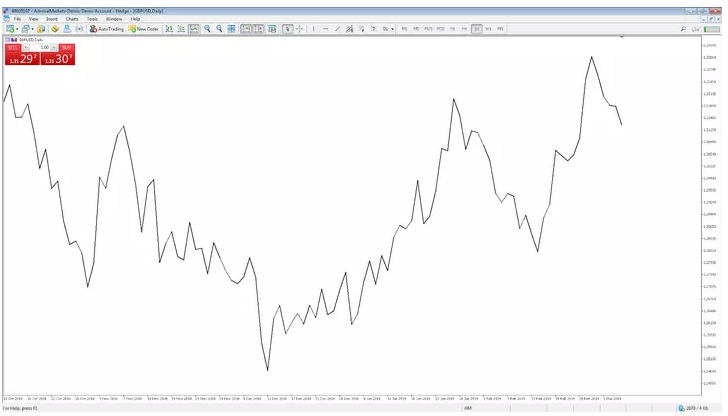
The sharp edges show the closing prices.
Bar charts: Also known as the OHLC bar charts shows a bar for every time period that you select. For example, if you are viewing EURUSD on the daily timeframe, a bar represents a day’s worth of trading.
Beyond closing prices, the bar chart also shows you the open, high, low, and close (OHLC) prices of the bar. The dash on the left shows the opening price and the dash on the right shows the closing price.
The high of the bar is the highest price the market traded while the low of the bar is the lowest price the market traded. All of these is shown on every single bar for the time period you select.
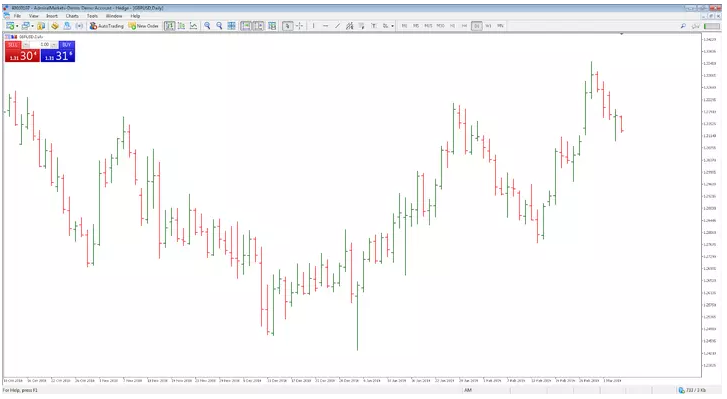
Candlestick charts: Candlestick charts are the most popular type of forex trading chart. Homma Munehisa developed the concept of candlestick charting. Like bar charts, they also show the OHLC.
The difference between them is that candlestick charts have a ‘body’. The ‘body’ of a candlestick is a rectangular box between the open and close prices.
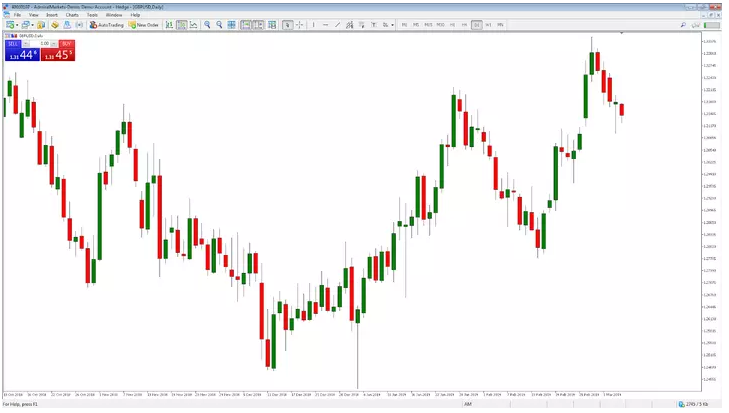
Chart Patterns
In analyzing the forex market, understanding chart patterns are crucial. You can use them to determine where the price will go, and whether a trend will continue or end.
However, there are some terms you need to know before moving to price patterns. They are support, resistance, breakout, and retracement.
Support: When supply exceeds demand in the forex market, the price begins to fall. This fall in price continues to a point where demand slowly exceeds supply. Consequently, the price stops falling. This is support.
Here is a pictorial illustration of support (see the areas with yellow boxes).

Resistance:Resistance is the opposite of support. The price of a currency will continue to rise as demands exceed supply. However, a point comes in the market where supply exceeds demand and the price stop rising. This is resistance.
Here is a pictorial illustration resistance (see the areas with yellow boxes).

Support and resistance can also occur diagonally on a trend line. They do not occur horizontally alone. Here is a pictorial illustration of diagonal support (see the areas with black boxes).

Support/resistance can be a single price or a zone. Typically, price reverse when they get to these zones. That is, price tend to start rising from a support zones and tend to fall at resistance zones.
This is not the case every time. Anytime there is no price reversal at support or resistance, what happens is a breakout.
Is forex trading halal?
Whether forex trading is halal depends on the specific practices involved and how they align with Islamic financial principles. Here’s a breakdown:
Prohibited elements in forex trading:
1) Riba (interest): Traditional forex trading often involves rollover fees or interest charges on overnight positions, which are strictly prohibited in Islam.
2) Maysir (gambling): Excessive speculation and high leverage can be seen as gambling, also forbidden in Islam.
3) Gharar (excessive uncertainty): Trading on margin involves borrowing money with a guaranteed return to the broker, which could be considered as an unfair exchange.
Compatible practices for halal forex trading:
1) Swap-free accounts: These accounts avoid rollover fees by closing open positions at the end of each trading day, eliminating interest-based charges.
2) Fixed fees: Some brokers offer fixed fees for each trade, removing the element of uncertainty associated with variable spreads and commissions.
3) Profit-sharing: Profit-sharing agreements between traders and brokers can replace interest-based income with a Sharia-compliant revenue model.
4) Limited leverage: Reducing leverage minimizes the risk of excessive speculation and debt.
Popular options for halal forex trading:
1) Islamic forex accounts: Many online forex brokers offer specific accounts that comply with Sharia law, often incorporating swap-free trading, fixed fees, or profit-sharing structures. Such forex brokers include HF Markets, Octa, AvaTrade, and XM Trading among others.
Things to consider:
1)Not all forex brokers offer halal alternatives. Ensure the platform and account structure adhere to Sharia principles.
2)Fees and structures may vary. Compare different brokers to find one that offers competitive fees and a Sharia-compliant structure that aligns with your preferences.
FAQs on Forex Trading New Zealand
How does the forex trading work?
Forex trading involves buying and selling currency pairs like EUR/USD, GBP/USD, EUR/GBP etc. A forex trader speculates on the prices of currencies. For example, if a trader thinks that the USD is going to be weaker in the next few weeks against the GBP, then that trader can buy GBP, that is the GBP/USD pair.
If the trader is right and the USD becomes weaker, the traded makes profits from the difference. Forex trading generally involves leverage, which is very risky as we explained in our guide.
Is forex good for beginners?
Forex trading is not very safe for beginners (new traders) as they can lose all their money. It is best that only experienced traders should engage in forex trading because of the risks involved.
Although beginners can engage in forex trading by first setting up a demo account and practising with virtual money to get familiar with how it works and the platform, before putting their real money. New traders can also learn about forex by watching video tutorials and attending webinars or seminars.
Is forex trading legal in NZ?
Yes, forex trading is legal in New Zealand. But you must only trade via FMA-regulated forex brokers to ensure that your funds are protected against third-party risk associated with brokers.
How much can I make on forex daily?
There is no guarantee of profits with forex trading. In fact, most of the retail traders trading forex lose their money. FMA requires all its regulated CFD brokers to publicly highlight the fact that traders can lose their capital. So, it is really important to understand the risks. And note that you could lose all your capital with forex & CFD trading.
Can forex make you a millionaire?
Trading Forex is very risky & most retail traders lose their money when trading CFDs as per data from FMA-regulated CFD brokers. About 70-85% of retail traders lose at CFD brokers (this number is lower for some brokers).
How do I begin forex trading?
Traders can participate in the market via FMA-regulated CFD brokers. You can open your account with any regulated broker. It is important to understand the risks involved before you trade Forex or CFDs as most retail traders lose their money.























